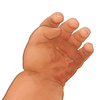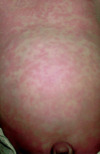
Figure 2. Maculopapular Rash on Hand
The rash associated with congenital syphilis often involves the soles and palms (as shown here on the palm of this infant’s right hand). The hand rash often becomes papular, followed by desquamation.

Figure 3. Maculopapular Rash on Face
The congenital syphilis rash can involve the face; if so, it is usually concentrated at the corners of the mouth and nose, with crusting and cracking.

Figure 4. Diffuse Skin Rash
Photograph of a 2-month old boy with congenital syphilis showing erythematous macules and papules with some scaling in the upper chest. This bright red rash in this boy represents an early phase of the generalized rash with congenital syphilis; these lesions typically fade to a more copper or rust color.
Source: Lugo A, Sanchez S, Sanchez JL. Congenital syphilis. Pediatr Dermatol. 2006;23:121-3. Reproduced with permission from Wiley.

Figure 5. Diffuse Skin Rash in Infant with Congenital Syphilis
Diffuse macular bullous rash on arms, hands, and abdomen of a 1-month old infant with congenital syphilis (Panels A & B).
Source: R Hirate T, Kanda K, Ohshima Y, Shinoda K, Tetsuka N. Congenital syphilis in a 2-month-old infant during Japanese outbreak. Lancet. 2024;404:971. Reproduced with permission from Elsevier.

Figure 7. Papulosquamous Patches with Biett's Collarette of Scale in an Infant with Congenital Syphilis
This photograph shows a newborn with congenital syphilis shows papulosquamous patches with Biett's collarette of scale on the anterior legs. This description of the collarette of scale was first described by Laurent-Théodore Biett in the early 19th century, refers to the narrow rim of peripheral scaling around syphilitic annular maculopapular lesions.
Source: Newton J, Silence C, Boetes J, Cohen BA. Mucocutaneous manifestations of congenital syphilis in the neonate: A review of a surging disease. Pediatr Dermatol. 2023;40:238-41. Reproduced with permission from Wiley.








































